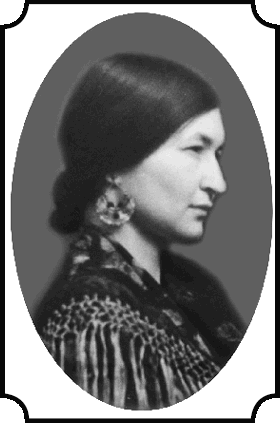My Gypsy Aunt

Her given name was Sarah and everyone called her Sadie, but to me she was my “Gypsy Aunt.”
She and my uncle, both artists, lived in the loft at Hull House. What an exciting adventure to visit her there! I had to cross the rickety bridge connecting the loft to the main building, holding my breath, making sure not to look down, hurrying into the hug that welcomed me at the doorway.
My aunt would be wearing a long dress in shades of purple, made of material hand-printed by my uncle. She knew I loved it when she “dressed up.” Lustrous black hair drawn back from her forehead, caught in a bun at the nape of her neck, and silver hoop earrings completed her gypsy look.
Sadie was eleven years old when, in 1911, she first visited Hull House and joined the art class of Enella Benedict, a dedicated and inspiring teacher with whom she studied for years. In her twenties she met Leon Garland, one of a group of aspiring artists who worked at boring jobs during the week, but were free on weekends to paint in the Hull House studio. They called themselves The Saturday Painters. Leon also taught batik at Hull House and, as one of his students, Sadie grew to know him well. They began sketching on Sundays in some lovely spots they discovered in what was then “the country.”
As if in a fairy tale, Sadie and Leon fell in love. In 1927, they were married at Hull House, with Jane Addams providing the wedding reception. They then moved together into the Hull House loft. Residents of Hull House were expected to volunteer their services to the settlement and so Sadie became Enella Benedict’s assistant, heading the children’s art department. One day a group of troublesome boys was brought to her class by a police officer who directed her to “do something with these guys.” At first she was flustered, but then she suddenly thought of putting the boys to work painting murals, which they enjoyed so much that they stopped causing trouble. Thus began Sadie’s use of art as therapy, which was to become the important work of her adult life.
While still in his thirties, Leon suffered a major heart attack. Required by doctors’ orders to rest for most of each day, he was forced to limit his painting to scenes from his early life in Russia and the Hull House neighborhood. His easel commanded the prime space by the large loft windows that overlooked the street.
While my uncle painted for the few hours the doctors allowed, I would sit with my chair pulled close to my aunt’s and she would entrance me with her stories, some made-up, some true. She was a born storyteller, and I was mesmerized by her husky, expressive voice, her dark eyes, and her graceful hands that “talked.”
In 1941 Leon had another heart attack from which he did not recover. Sadie was heartbroken by his death, but eventually remarried Rudolph Dreikurs, a Viennese psychiatrist who regularly consulted with the Hull House social service staff. He had become a friend to both Sadie and Leon and soon moved to Hull House, where he helped to sustain the grieving Sadie. During these years Sadie apprenticed to Jane Addams and became an able social worker in her own right, eventually serving as a full-time case worker at Hull House.
But my Gypsy Aunt visits had been interrupted. Sadie and Rudolph moved out of Hull House, and began frequent travels abroad where Rudolph was in demand as a lecturer. Working closely with Rudolph, Sadie learned much about psychology and combined this with her knowledge of art to further develop the practice of art therapy.
A half-century later, some years after Rudolph’s death, the magic resumed; I began to visit my aunt in her high-rise apartment overlooking Lake Michigan. The walls were completely covered with Leon’s paintings and some of her own. We would enjoy a cup of tea and, once again, my aunt would tell me stories.
Now the stories were about her own childhood, and her life as a young woman at Hull House. Sadie had been a middle child, two years younger than her sister Charlotte, and five years older than her brother Charles. She had been born and raised on Chicago’s West Side; her parents were immigrant Jews from Lithuania. Her meeting with fellow art student Blanche Maggioli, who was responsible for Sadie’s first visit to Hull House (and later became a designer with the Walt Disney studios), turned out to be one of the most important events of her long life, because as Sadie once said, everything of significance that happened to her came from her association with Jane Addams and Hull House.
But most of her stories were of Jane Addams, of the marvelous women of Hull House, and of the rich world they created within the sooty tenements of Chicago—stories about how Jane Addams gave the job of washing Hull House windows to an out-of-work trapeze artist, who performed in high style for the entertainment of wide-eyed children; and about how her complaints that garbage wasn’t being picked up in the Hull House neighborhood led the city to appoint her a garbage inspector.
At the end of her life my aunt’s hair was still long and lustrous, though by then it was almost snow white. She still wore it drawn back and fastened in a bun at the nape of her neck. And my Gypsy Aunt was still a natural storyteller.
The young Sadie of my aunt’s stories, growing up in the Hull House neighborhood with her dream of becoming a fine artist, captured my imagination. When Sadie died at age ninety-six, in 1996, I thought it would be a special kind of writing adventure to make that young Sadie—the girl who became my Gypsy Aunt—the heroine of a novel. And so Her Mother’s Secret was born.